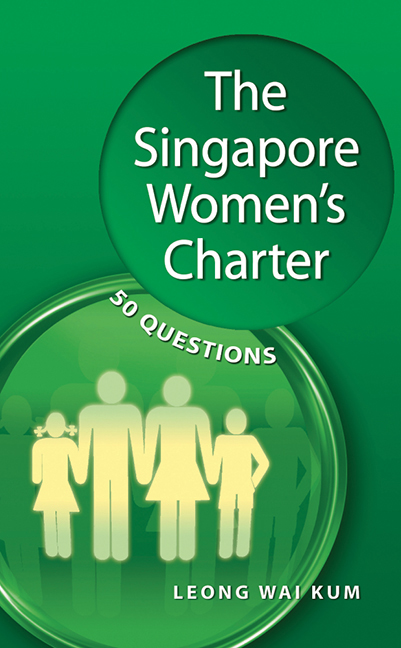Book contents
- Frontmatter
- Contents
- List of Questions
- Foreword
- Preface
- Part I What is the Women's Charter?
- Part II Marriage
- Part III Regulation of Husband-Wife Relationship
- Part IV Regulation of Parent-Child Relationship
- Part V Violence in the Family
- Part VI Divorce and the Process
- Part VII Maintenance
- Part VIII Division of Matrimonial Assets
- Part IX Muslims
- Epilogue
- References
- Index
- About the Author
Part VIII - Division of Matrimonial Assets
Published online by Cambridge University Press: 21 October 2015
- Frontmatter
- Contents
- List of Questions
- Foreword
- Preface
- Part I What is the Women's Charter?
- Part II Marriage
- Part III Regulation of Husband-Wife Relationship
- Part IV Regulation of Parent-Child Relationship
- Part V Violence in the Family
- Part VI Divorce and the Process
- Part VII Maintenance
- Part VIII Division of Matrimonial Assets
- Part IX Muslims
- Epilogue
- References
- Index
- About the Author
Summary
What does the Women's Charter allow of the matrimonial assets of a couple upon their divorce?
Section 112(1)
The Women's Charter in section 112(1) gives the Family Court a very broad discretionary power to make an order that divides the parties’ matrimonial assets between them in just and equitable proportions. This power arises only upon the termination of their marriage by a judgement of court.
The power was enacted and added to the Women's Charter in 1980 (although at that time it was section 106). The enactment of this law was a remarkably bold step the Parliament of Singapore took in 1980. A power of this nature stems from a view of the acquisition of property by spouses during marriage that was originally associated with countries that belong to the “civil law” family of legal systems (eg. France or Sweden). Singapore (just like England) belongs to the alternative “common law” family of legal systems which held a different view of the acquisition of property by spouses. Even today England still does not have a statutory provision that is worded quite as boldly as Singapore's Women's Charter's section 112. However, as the idea behind section 112 has become widely accepted as the fair way to treat spouses’ property upon their divorce, the House of Lords — now called the Supreme Court of England (the highest court in England) — decided in 2000 that English courts should also exercise their power to achieve a fair distribution of the property that divorced parties own at their divorce. In other words, Singaporeans can note with some pride that our law in this respect developed ahead of the law in England by about twenty years.
No similar power during the subsistence of marriage
The significance of the power to order the division of matrimonial assets of a couple upon divorce can be appreciated when one remembers what the common law rule is regarding ownership of property between a husband and wife during the course of their marriage. Family law in Singapore (like that in England) leaves the regulation of property between a husband and wife completely to the general principles of property law. Family law does not provide special principles for the married couple.
- Type
- Chapter
- Information
- The Singapore Women's Charter50 Questions, pp. 101 - 120Publisher: ISEAS–Yusof Ishak InstitutePrint publication year: 2011

